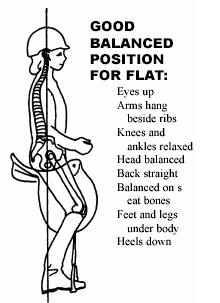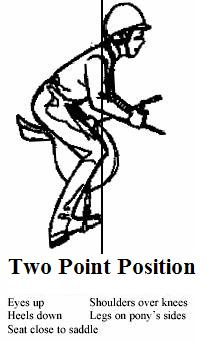|
THE
BALANCED POSITION DE-MYSTIFIED
by Marilyn Yike, former Vice President of Instruction
(This article is reprinted from
Winter 1994 USPC News)
Basic Balanced Position
You’ll hear
this phrase over and over again as you progress through the standards. Do you really know what it means? What
is primary where riding in Pony Club is concerned? First, the balanced position is the foundation for riding
in Pony Club. Second, the progression of the Standards is built around the basic seat. A balanced position
means the rider is balanced on the horse and in balance with the horse’s movement. This position allows
more effective application of the aids, gives better control of gaits, and is more comfortable for both horse and
rider. By being in balance, the rider does not use muscle power to maintain his position, but relies on the same balance
used in standing and walking. This allows the body to relax and be able to move with the horse’s motion. A balanced
rider permits the horse to move more freely and naturally, not impeded by a lack of rider stability and able to maintain
its own balance and respond to its rider’s aids. Other specialized styles of riding, such as hunt seat, saddle
seat, and western, are all adaptations of this same balanced seat.
Taught in Earliest Lessons
Pony Club teaches the balanced position from the earliest lessons.
The D-1 test requires demonstration of correct position (at the halt). The position described for beginners
remains unchanged for upper levels; it merely develops sophistication, becoming more secure, independent, and
effective. The most common reason for failure in the riding sections
of the upper-level testing is lack of basic position, which prevents an independent seat and hinders effectiveness.
The seat cannot become independent if it is not balanced. The aids cannot be effective without an independent
seat. The balanced seat is primary! For riding in a balanced position on the flat, the rider should sit on
the seat bones, shoulders over hips, head carried erect, arms hanging relaxed from shoulders, elbows at sides
and bent, allowing forearm and hand to maintain a straight line to the bit. The relaxed leg should lay softly
against the horse’s sides, knee pointing down, heel under hip, toe lifted into stirrup, stirrup leather remaining
vertical. For jumping and for posting to the trot, the hip angle closes slightly, bringing the shoulders forward
over the knees. The heel remains under the hip, maintaining the rider’s balance over the horse. This
is the two-point or half-seat position.

Knees Flexed, Body Upright
The riding position is the same on the horse as it is on the ground. Stand with
feet apart, knees flexed, body upright. If you are not balanced, you will fall over! Ride a horse with the same balance,
feet under seat. Use that “on the ground” image to check for correct position. Visualize the rider without
the horse. Would the rider stand… or fall? The two most common position faults are these: First, the
rider’s upper body is tipped forward, perched on crotch bones, causing the leg to be unsteady. Second
is the modified chair seat with rider sitting on tailbone, legs forward rather than under seat. Neither is
balanced, and both inhibit effectiveness.

Imbalanced Rider, Imbalanced Horse
The
rider’s tipped-forward position places his weight in front of the horse’s center of balance, pushing
him onto his forehand and making it difficult for him to balance himself. The rider’s seat bones are
not in contact; the legs move back and forth. The rider is in front of the horse’s motion. The chair seat
places the rider’s weight on the back of the saddle and behind the motion of the horse. The seat bones
are in a constant driving position. This is uncomfortable for the horse, which then hollows its back and raises
it’s head. It cannot relax or round its back or move freely forward on the aids. Again, effectiveness of the rider’s
seat and legs is lost. The rider must be balanced laterally, as well. Some riders sit unevenly, collapsed through
the waist, pushing the hips to one side and tilting the shoulders to compensate. Watch the rider from behind
to check for straightness. The horse cannot be straight if its rider is crooked.
|



